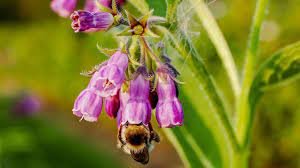July 2023 - Musings, How to choose or make plant feed and more
July Musings
late summer
It seems strange to be writing about autumn in the heat of summer, but as I look around the beginnings of our garden in Bishopstone, my thoughts turn to next season and which plants will shine from late September onwards. I love the movement of grasses with their feather-like seed heads and the rich colours of sedums and rudbeckia. My shopping list for other autumnal beauties, needed to plug any gaps, is being written.
July Feature-Plant Feed / Fertiliser
So much choice!
I’ve recently had a couple of questions about fertilisers, Ooh the glamour! There’s a confusion of choice in the shops and it’s easy to get bamboozled by all the different types of plant feed, and when to use it. Here’s a quick guide to help you choose which is best for your gardening needs.
There are two main types of fertilisers and they both usually come in soluble and granular/pellet form:
Inorganic fertilisers: Synthetic forms of plant nutrients, usually more concentrated and fast acting such as Growmore, Miracle Gro & Phostrogen. They are often soluble, and application will need to be repeated weekly or fortnightly, they are often used to maximise plant growth so great in the spring and summer.
Organic fertilisers: Derived from plant or animal sources, that tend to be slower acting but longer lasting. Examples include dried fish, blood & bone & poultry manure pellets, usually applied in early spring and late summer. The exception being Liquid seaweed, liquid comfrey or nettle feeds which can be applied weekly or fortnightly through the growing season, I’ve included a recipe for you to try at home!
A quick science lesson to help you choose which nutrient mix to use:
Most fertilisers are based on three major plant nutrients:
(N) Nitrogen: For green leaf growth
(P.) Phosphorus: For healthy root and shoot growth
(K) Potassium: For flowering, fruiting, and general hardiness.
A general fertiliser offers a balance of all three major nutrients, plus lots of minor ones along with trace elements. All fertilisers should quote their N:P:K ratio on the packaging and its always worth checking the balance to ensure the best nutrient ratio for your plants.
Which nutrients do you need to feed your plants?
High potassium (K) feeds, such as liquid tomato feed) are great for tomatoes and other fruiting veg.
· Rose feeds are rich in magnesium & potassium.
· Lawns will appreciate a Nitrogen (N) rich feed in spring and a balanced ratio (N:P:K) feed in autumn.
· Container grown plants, annuals and bedding will benefit from a fortnightly general purpose (balanced N:P:K) liquid feed or try making your own from the recipes below.
· Established plants in the ground enjoy a spring and late summer application of organic fertiliser, gently raked into the surrounding soil, (I use chicken pellets or blood, fish, and bone), as a top dressing and in the soil around the roots when planting large shrubs.
· Acid loving plants such as Japanese Acers thrive with ericaceous feed.
Quick tip: the compost or soil should be moist at the time of application, so water first, then feed!
Fertilisers can help your plants to flourish but without soil conditioners such as mulches, their effectiveness is limited. More on soil conditioning next month.
Recipe: Make your own fertiliser/plant food
Comfrey
Home made fertilisers are much weaker than chemical ones but also much safer, cost effective and environmentally friendly. I don’t recommend human consumption!
Nettle Feed: Add about 1kg, (2lb) of nettles to 10 litres (2 gallons) of water, leave for about two weeks and use at a dilution of 10:1.
Comfrey Feed: Add 1kg of Comfrey leaves to 15 litres (3 Gallons) of water and leave for 6 weeks in a sealed container, then use undiluted.
Wormery liquid should be diluted with water until it’s the colour of weak tea, usually at a ratio of 10:1
Enjoy!
July’s Plant Spotlight- Larkspur (Delphinium) & Water Lilly
Larkspur
Given as a birth flower for July, the larkspur signifies love and joy. Larkspur is the common name given to perennial species of Delphinium and annual species of Consolida. Delphinium, in turn, comes from the Latin word for dolphin, and refers to the shape of the nectar-filled spur of the flower. And larkspur? That’s because it resembles the bird’s long hind claw.
The larkspur is a classic cottage garden plant, best at the back of a mixed border. It does well in Britain’s relatively cool summers, and may struggle in the heat. This is a member of the buttercup family – you’ll see the resemblance if you look closely at the leaves.
Water lily
Water lily
The water lily family, Nymphaeaceae, is native to tropical and temperate regions of the world, including the UK. British natives such as Nymphaea alba look exotic, yet are surprisingly hardy. They flower for six months a year, and cover up to nine square metres of water. There are also miniature species, with teacup-sized flowers that will grow in a small bowl and make a great tabletop or balcony water feature.
At the other end of the scale is the extraordinary giant Victoria amazonica, the world’s largest water lily. This native of the Amazon region has tea tray-like flowers up to three metres in diameter, and caused a huge stir when it made its public debut in Britain. The gardener, architect and member of parliament Joseph Paxton was the first to bring it to flower, and later used its ribbed leaves as the inspiration for the Crystal Palace.
The Potting Shed: Things to do in –July
· Deadhead (remove fading or dead flowers) to encourage more blooms
· Clear algae, blanket weed and debris from ponds
· Pick your courgettes before they become marrows
· Order catalogues for next years spring bulbs
· Give the lawn a quick-acting summer feed, especially if not given a spring feed
· Autumn crocuses, colchicum, sternbergia, Amaryllis & Nerine can all be planted now
· Cut back delphiniums & geraniums after the first flower flush to encourage a second flowering period
· Take cuttings of patio and container plants ready for next year
· Start to collect seeds from the plants you want to grown next year, especially annuals such as calendula, poppies and love-in-a-mist
Happy Gardening!






